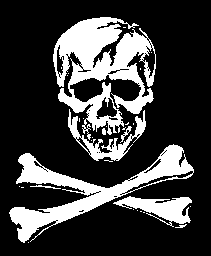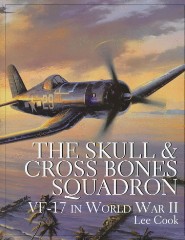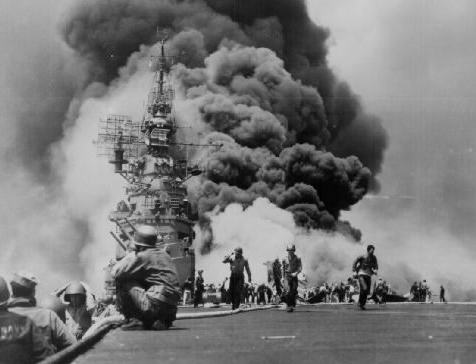Corsair Aces of VF-17, "The Jolly Rogers"
Ira Kepford
Roger Hedrick
By Stephen Sherman, Sept. 1999. Updated July 1, 2011.
Ira Cassius "Ike" Kepford
Ira Cassius Kepford was born on 29 May 1919 in Harvey, Illinois, son of George and Emma Kepford. He was a star halfback at Northwestern University, where he joined the U.S. Naval Reserve in 1941. He was honorably discharged from the Reserve on 29 April 1942, and accepted an appointment as a Naval Aviation Cadet. Kepford earned his wings at Corpus Christi, Texas and Miami, Florida on 5 November 1942, and was assigned to VF-17, the famous "Jolly Rogers," the following January.
He was one of the original hellions of this famous squadron, and was confined to quarters for ten days for mock dogfighting a P-51 right above the city of Norfolk. After training, the squadron arrived at New Georgia in the Solomons in late October, 1943.
Battle of the Solomon Sea
On the Nov. 11, 1943 strike at Rabaul (also known as the Battle of the Solomon Sea) Kepford downed four enemy aircraft, for which he was awarded the Navy Cross. Flying cover for the carriers in Roger Hedrick's flight, he lit into a gaggle of Kates. Flying through Bunker Hill's intense AA, he downed a Kate only 1,000 yards from the ship. Low on fuel, he started back to base when he spotted six unescorted Vals. Making the most of the opportunity, he quickly downed three of the slow, nearly helpless dive bombers. During his firing run on a fourth Val, he ran out of ammo and realized he was practically empty of fuel. Ike radioed for a course and permission to land on a carrier. Bunker Hill took him aboard, happy to honor one of their flying defenders. Even the distinguished Capt. Ballentine was pleased to serve Ensign Kepford a cup of coffee. After a relaxing half-hour, Kepford took off in his re-fueled and re-armed Corsair. He racked up four kills and eleven hours of flight time that day.
Leading a division on a Jan. 27 escort over Rabaul, Kepford destroyed two Zeros that were attacking another division.
On January 29, Kepford led his wingman, "Teeth" Burriss, in an attack on 12 Japanese fighters over Rabaul; he scored four kills, and was awarded a Gold Star for this action. Kepford and Burriss made up half of a Roving High Cover mission; the other two planes had aborted. As the bulk of the American strike/escort force flew in at about 15,000 feet, a dozen Zeros at 24,000 lurked above them. Ike and Teeth got in first, and in textbook series of dives, overhead firing passes , and recoveries, they both shot down four Zeros.
Only a few of the uncoordinated Zeros were even able to
engage the regular escorts. As
Lee Cook noted in his authoritative history of VF-17, The
Skull & Crossbones Squadron: VF-17 in World War II, Kepford and
his mates were the top guns of their day, feared by the Japanese
fighter pilots who described them as "attacks on us by wolves."
This book is comprehensive and includes:
- over 300 WWII era B&W photos
- detailed appendix of all squadron aces
- listing of every confirmed victory
- squadron war diary
Read the moving comments about the book at Amazon.com by Cdr. William "Country" Landreth, another pilot of the Jolly Rogers.
With ten aerial victories, he was the Navy's leading ace at that time. That evening, the CO of VF-17, Tom Blackburn chewed them out (!?) for recklessness and over-confidence. He scored two more the next day on a emergency scramble to Rabaul. Another Zero on Feb. 3.
Escape over Rabaul
The mission set for Feb. 19, 1944 was typical for the fliers of VF-17 that month: 20 planes on a strafing mission to Rabaul. Butch Davenport led the division; Ike was number 3. They took off at 0800, northwest towards Rabaul. Kepford's wingman soon developed engine trouble and was forced to return. Kepford was ordered to turn also back; he turned south, but kept rubbernecking and shortly spotted a lone Japanese Rufe seaplane. Although he was alone, Kepford dived down and opened up. The six .50's shook the Corsair and rippled holes in the enemy plane. As he pulled out of his dive, Kepford glanced back and saw the floatplane crash into the water. An easy kill behind him, Kepford turned south for home, radioing "Hog 29 here. Scratch one. Returning to base."
But then he saw many, many dots, high above him and in between him and Bougainville. He hoped to remain inconspicuous, but four Zeros peeled off to attack him. Unwilling to fight the whole group, he turned north to escape them, but the four pursuers came on fast, with their tremendous altitude advantage. As the lead Zero came on fast and opened fire, Kepford decided to "go for broke." He dropped his flaps and landing gear and nosed down until he was skimming the waves; as the Zero roared over him, he pulled his Hog's nose up and opened fire. The Zero's stabilizer crumpled under the snapshot, and the plane crashed into the waves. As Kepford pulled in his gear and flaps, the remaining Zeros bracketed him . . . he was facing 3-to-1 odds, low and slow, and he was heading back in the direction of Rabaul.
The other three Zeros spread out behind him, boxing him in, and continued to gain. Tracers streaked by! It was time to use the newly installed water injection "War Emergency Power" WEP, a temporary boost to the Pratt & Whitney R-2800 engine. The Jap planes stayed with him, scoring some hits on the F4U. He was really trapped at this point, unable to turn because of the Zeros behind, and forced to continue speeding north, while not gaining appreciably. Slowly, he began to pull away, but the WEP started to over-heat the engine. He got out of range and eased back on the throttle a bit, disengaging the WEP.
Kepford had to make his move now! He cut across the path of the port Zero. The Japanese plane dropped to wavetop level, opened fire, and sharply turned, trying to turn inside Kepford. At which point the Zero's left wing caught a wave top, and the plane cartwheeled across the ocean surface, disintegrated, and sank. The other two Zeros were left behind as Kepford dashed for home, landing on fumes in his fuel tank. He struggled out of his plane, pale and exhausted. His flying suit and shoes were soaked through with sweat. As the tension of the nerve-wracking four hour mission lifted, he shook all over and tears streamed from his eyes.
Honors and Medals
With 16 confirmed kills at the end of February, Kepford was still the Navy's top ace, a distinction he retained until Alexander Vraciu went wild on June 19. Kepford returned to the States in March of 1944, and was assigned to Fleet Air Command at Alameda, California. In June, he was transferred to VF-84. In December, he was attached to the Staff of Commander Fleet Air, West Coast, where he served the remainder of WWII. In his five months of combat duty, Ira Kepford earned two Navy Crosses, the Gold Star, the Silver Star, three Distinguished Flying Crosses, the Air Medal, Unit Commendation to VF-17, and the American Defense Service Medal.
Postwar
Kepford retired from the Navy with the rank of Lieutenant Commander on 1 June 1956. He worked for Rexall Drug Stores afterwards, rising quickly to become president of the company's eastern division.
- Edward Sims, Greatest Fighter Missions, Harper and Brothers, 1962 - includes a fuller version of Kepford's Feb. 19 "Escape from Rabaul" mission, along with many other Navy and Marine ace stories
- Tom Blackburn and Eric Hammel, The Jolly Rogers, Pocket Books, 1989
Roger Hedrick
No Exec was closer to his Commanding Officer than Roger Hedrick was to Tom Blackburn, and no other XO shot up his CO's aircraft.
Relationship with Tommy Blackburn
Together, the two officers made VF-17, the famed "Jolly Rogers," operate as a cohesive team. Hedrick completed flight school in 1936, as part of the Navy's Aviation Cadet program, which supplemented the Navy's thin ranks of naval aviators in the late 1930's. The two men first worked together at the Miami Naval Aviation training school in 1941, and when Blackburn organized VF-17 in December of 1942, he promptly selected Hedrick as his Executive Officer. He served with the "Jolly Rogers" squadron for its whole combat career.
Ondongo
Originally they had planned and trained to be a carrier-based squadron, working with Chance-Vought to iron out the problems with the Corsair's bouncy landing gear, poor visibility, and other 'minor' issues. While VF-17 did qualify for carrier operations with the F4Us, the Navy high command decided to deploy them on land, where they could take advantage of the Marines' logistical support and spare parts. They set up their base at Ondongo, meaning "Place of Death," on New Georgia in the mid-Solomons on October 27, 1943. This was just in time for the landings at Torokina, near Empress Augusta Bay on Bougainville.
November 1
Hedrick flew his first combat mission and scored his first kill on November 1. He took up VF-17's fourth flight of eight planes, to provide top cover for the landings. Before reaching Torokina, sharp-eyed Hedrick spotted several specks, 'bogies', where no Allied planes were reported. As his radio was out, he rocked his wings to signal the attack, but no others in his flight spotted the Japs. He closed in on the Jap leader, got within range, aimed for the Zero's wing root, and flamed it. The remaining Zeros scattered and headed for the deck. Now Hedrick's flight mates dived after them, but the Japanese pilots' well-executed vertical scissors maneuvers kept the Corsairs at bay.
November 8
On November 8, Hedrick led VF-17's third mission of the day, an eight-plane flight on CAP over Empress Augusta Bay. Two planes aborted early, leaving six circling over the area for about an hour, when the command ship radioed "Bogies!" They swung southwest in a full-power climb. In minutes, he spotted about two dozen Zeros, covering fifteen Vals. He promptly gave chase with his 4-plane division, ordering two to provide high cover. Hedrick was astonished to see the more numerous Zeros respond to his attack by going into a defensive Lufbery circle, while the Vals retired to the north. With his initial altitude energy advantage, he planned to 'boom-and-zoom' the Lufbery, making repeated firing runs. During the ensuing dogfight the three 2-plane sections kept their integrity.
| Hedrick and his wingman, Mills Schanuel, blasted the Japs on their first firing run; Hedrick's went into a cloud, Schanuel's flamed. They chased some Zeros northward, and became briefly separated during a series of head-on battles. Hedrick shot up several Zeros, and saw them streaming "big buckets" of fuel, but no flamers. The pair soon joined up and returned safely. | The 2nd section, Anderson and Chasnoff, opened up on a Hamp, and broke up the Lufbery on their first run. The pair stayed together for six more passes, but with no more hits. They also were pulled north, only to be bounced by several Zeros. Chasnoff's tail was badly chewed up, but these two also made it back to Ondongo. | Cordray and Cunningham stayed at 29,000 feet high cover until another group of Zeros went by, then they dived into the fray below. By then the Lufbery circles had broken up, and Zeros were all over. Cunningham got a flamer, which they followed down long enough to confirm the kill. Then they headed home, arriving just after Hedrick. |
While the official records only credited the flight with two kills (one each to Schanuel and Cunningham) and five 'damaged', the battle removed Hedrick's remaining skepticism about the Corsair. This had been the first real test of the F4U in a maximum combat situation, and it made a believer out of Hedrick. He had experienced first-hand how the Corsair outclassed the Zero in all fighting qualities except maneuverability.
Three days later VF-17 went up to fly cover on a carrier Task Group attacking Rabaul. After the carriers launched their strike planes, Hedrick's flight landed on Essex, while Blackburn's landed on Bunker Hill. Taking off again in the afternoon, they got involved in a confusing dogfight with many Japanese. Hedrick suddenly noticed a plane coming out of a cloud, crossing in front of him. He fired a deflection shot, but ceased firing immediately when he recognized his target as a Corsair. The victimized pilot turned out to be the CO, Tom Blackburn, who described the event in his book, The Jolly Rogers:
Anguish and concern written all over his face Rog Hedrick pulled up beside me to the left. After closely inspecting Big Hog, Rog shook his head and passed a questioning thumbs-up signal - was I okay? To my right Mills Schanuel did much the same, as I rapidly actuated various controls and scanned the gauges to check for damage. All apparently was okay.
On landing back at Ondongo, Blackburn's only complaint was that Hedrick was a lousy shot. Hedrick also managed to down an enemy plane this day.
November 17 - While on CAP over Empress Augusta Bay, Hedrick's eight-plane flight downed 10 Jap planes (1 for Hedrick personally), but at the cost of Brad Barker, who just disappeared during the dogfighting.
Escorting some SBD's on a Rabaul raid on Jan. 26, 1944, Hedrick downed a Zero just as it was setting up to hit the dive bombers.
He led the first Roving High Cover (RHC) mission for the Jolly Rogers on Jan. 28. Leading six planes at 32,000, he spotted a dozen Zeros about to attack the standard bomber/fighter escort group. On his first three passes most of his guns jammed. After Paul Cordray cleared his tail, he got all six guns working and dived onto a lone Zero at low altitude. He flamed it, the pilot bailed out, and Hedrick strafed the chute. (I thought we wore the white hats. - SS) Cordray then dived onto a second Zero and sent it down. Hedrick's third RHC pair also scored. Four kills for the RHC team and a thoroughly disorganized Japanese defense.
He shot down one on Jan. 30 and three on February 18, making nine that he scored with VF-17, which broke up in April, 1944.
Roger Hedrick later commanded VF-84 on Bunker Hill. Their primary mission was to stop the kamikazes. He destroyed a Zero and 2 Franks on February 25, 1945, to bring his final score to 12 confirmed and 4 damaged. But on May 11, 1945, a kamikaze got through, hitting the carrier right below the island, killing most of the pilots in the ready room. Hedrick survived, but that was the end of Bunker Hill's combat tour. Another Navy Squadron, also based on Bunker Hill, was numbered VF-17, but it was a wholly new outfit, unrelated to Blackburn, Hedrick, Kepford, et al.
After the war, Hedrick stayed in the Navy, rising to the rank of
Rear Admiral.
Sources:
- Tom Blackburn and Eric Hammel, The Jolly Rogers, Pocket Books, 1989
- Mark Styling, Corsair Aces of World War 2, Osprey Publishing, 1995




